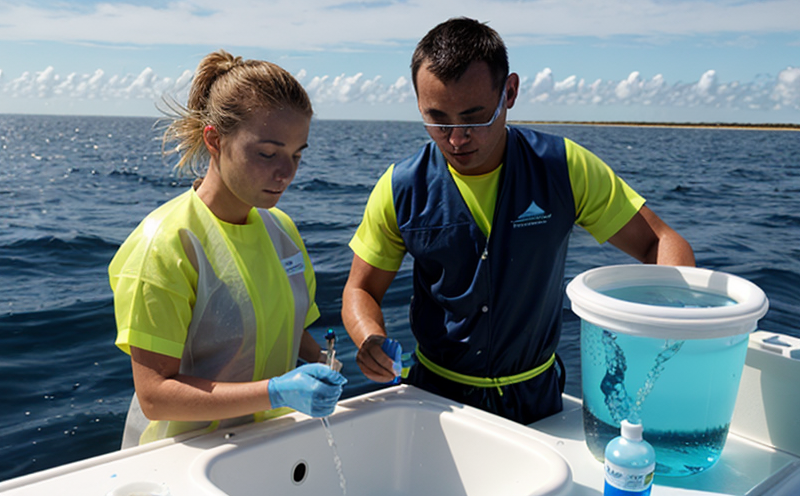APHA 4500-Cl Chlorine Residual Test in Seawater
The APHA 4500-Cl method is a widely recognized protocol for measuring chlorine residual in various water samples, including seawater. This test is crucial for ensuring the safety and quality of drinking water as well as for monitoring water treatment processes. Chlorine residuals play a significant role in controlling microbial growth and maintaining water quality standards.
In marine environments like seawater, the presence and concentration of chlorine are critical to prevent contamination from harmful microorganisms such as bacteria and viruses. The APHA 4500-Cl method is particularly important for seawater testing because it helps assess the disinfection efficiency and the adequacy of water treatment processes.
The procedure involves a series of steps that ensure accurate measurement of chlorine residuals. First, a representative sample of seawater is collected from the desired location. This sample must be carefully handled to avoid contamination with external sources of chlorine or other oxidants. Once collected, the sample should be analyzed as soon as possible, ideally within 24 hours.
The actual testing process begins by preparing the sample in a laboratory setting. The sample is mixed thoroughly and then titrated against standardized sodium thiosulfate solution using a starch indicator. This titration helps determine the concentration of free chlorine present in the seawater sample. The endpoint of the titration is signaled by the disappearance of the blue color of the starch indicator.
It's important to note that different forms of chlorine can be present in seawater, including free chlorine (Cl2), combined chlorine (NClx, where x = 3-5), and total chlorine. The APHA 4500-Cl method specifically measures free chlorine residual. Understanding these different forms of chlorine is crucial for interpreting the results correctly.
The accuracy of this test is paramount, especially in marine environments where seawater chemistry can be complex and variable. Factors such as pH, temperature, salinity, and the presence of organic matter can influence the behavior of free chlorine in the water. Therefore, it's essential to ensure that all conditions are optimized during sample collection and analysis.
| Standard | Description |
|---|---|
| APHA 4500-Cl | This method covers the titrimetric determination of free available chlorine in water using sodium thiosulfate solution. It is applicable to various water types, including seawater. |
The results of the APHA 4500-Cl test provide critical information for quality managers and compliance officers responsible for ensuring that seawater meets regulatory standards set by agencies such as the WHO (World Health Organization) or EPA (Environmental Protection Agency).
R&D engineers also benefit from this method, as it allows them to fine-tune water treatment processes. By measuring chlorine residuals accurately, they can optimize disinfection techniques and ensure that seawater is safe for its intended use.
Why It Matters
The measurement of chlorine residual in seawater is vital for several reasons. First, it ensures the safety of marine environments by preventing the growth of harmful microorganisms that could pose a risk to human health or marine life.
Secondly, accurate monitoring helps compliance officers ensure that water treatment processes adhere to regulatory standards and guidelines set forth by international bodies like ISO (International Organization for Standardization) and WHO. This is crucial for maintaining public trust in the quality of seawater.
In addition, understanding chlorine residuals can help R&D engineers develop more effective and sustainable water treatment methods. By continuously monitoring the effectiveness of disinfection processes, they can identify areas for improvement and introduce new technologies that enhance water safety.
The presence of adequate chlorine residual also ensures that seawater is suitable for various applications, such as recreational activities, aquaculture, and industrial uses. This makes it essential for both environmental protection and economic benefits.
Applied Standards
- ISO 10684:2015 - Water Quality Determination of Free Available Chlorine by Titrimetric Methods
- ASTM D1129-17 Standard Practice for Preparation and Preservation of Samples of Sea Water
Environmental and Sustainability Contributions
The accurate measurement of chlorine residuals in seawater contributes significantly to environmental sustainability. By ensuring that disinfection processes are effective, this test helps reduce the risk of contamination from harmful microorganisms. This not only protects human health but also promotes the well-being of marine ecosystems.
Moreover, the data obtained from these tests can be used to inform policy and decision-making processes related to water quality management. This supports broader efforts aimed at preserving and protecting aquatic environments for future generations.





